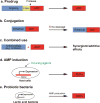Host defense antimicrobial peptides as antibiotics: design and application strategies
- PMID: 28399505
- PMCID: PMC5494204
- DOI: 10.1016/j.cbpa.2017.03.014
Host defense antimicrobial peptides as antibiotics: design and application strategies
Abstract
This review deals with the design and application strategies of new antibiotics based on naturally occurring antimicrobial peptides (AMPs). The initial candidate can be designed based on three-dimensional structure or selected from a library of peptides from natural or laboratory sources followed by optimization via structure-activity relationship studies. There are also advanced application strategies such as induction of AMP expression from host cells by various factors (e.g., metals, amino acids, vitamin D and sunlight), the use of engineered probiotic bacteria to deliver peptides, the design of prodrug and peptide conjugates to improve specific targeting. In addition, combined uses of newly developed AMPs with existing antimicrobial agents may provide a practical avenue for effective management of antibiotic-resistant bacteria (superbugs), including biofilms. Finally, we highlight AMPs already in use or under clinical trials.
Copyright © 2017 Elsevier Ltd. All rights reserved.
Figures


References
-
- National Action Plan for Combating Antibiotic-resistant Bacteria. the White House; Washington: Mar, 2015.
-
- Hansen V, Oren E, Dennis LK, Brown HE. Infectious Disease Mortality Trends in the United States, 1980–2014. JAMA. 2016;316:2149–2151. - PubMed
-
- O’Neill J. The Review on Antimicrobial Resistance: Tracking drug-resistant infections globally. UK: Dec, 2014.
-
- Boman HG. Antibacterial peptides: Basic facts and emerging concepts. J Inter Med. 2003;254:197–215. - PubMed
Publication types
MeSH terms
Substances
Grants and funding
LinkOut - more resources
Full Text Sources
Other Literature Sources
Medical

